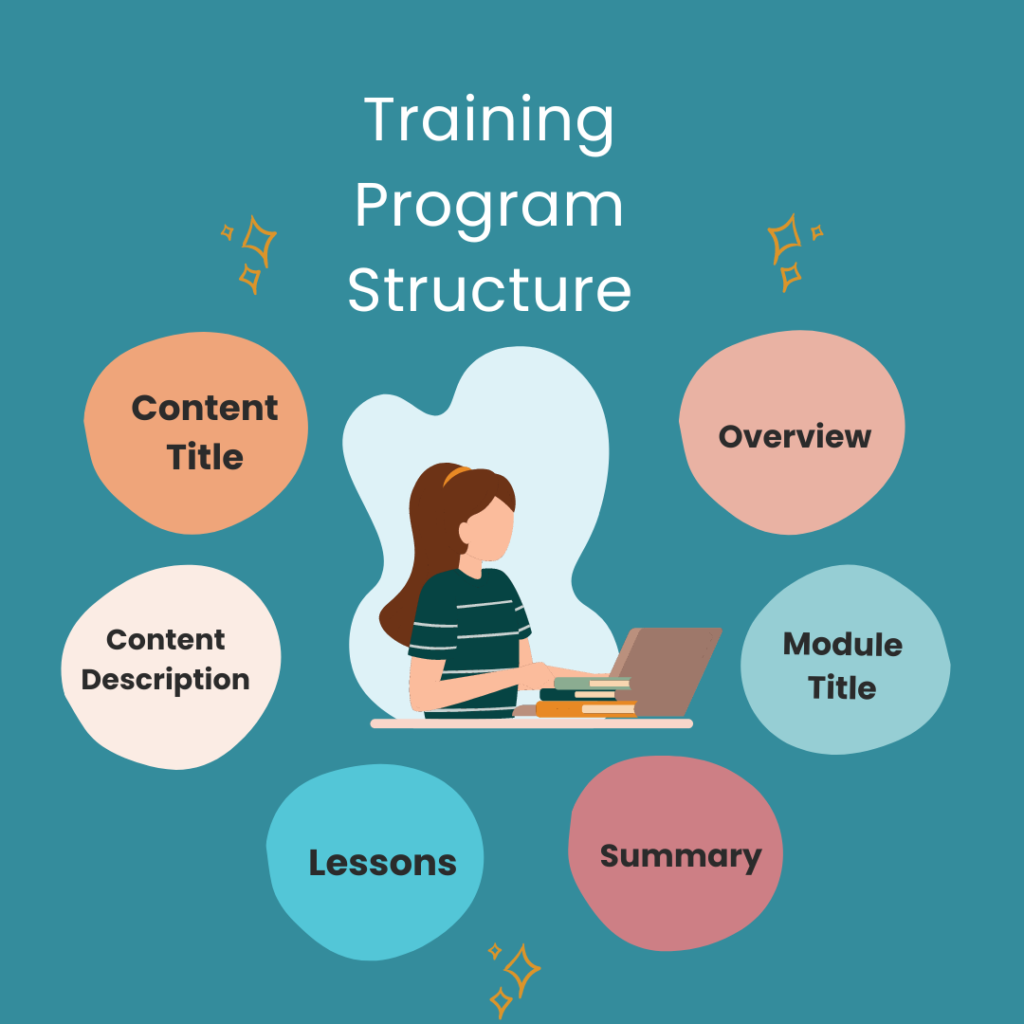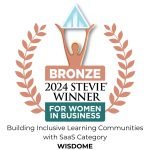Today I’m excited to share with you tips on how to effectively create content for your training program. You can use this framework to transform your ideas into coaching programs, courses, or memberships. Let’s dive in!
Tip #1: Organising Content for Your Course, Coaching or Membership Business
Your content outline serves as the backbone of your course, coaching program, or membership content. In this section, we’ll provide you with a content framework to help you:
- Narrow down your objectives
- Streamline your message
- Keep your audience motivated to achieve their goals
Create Your Training Program Content Overview
Your content overview is the introductory section providing learners with a broad understanding of what your course or training program is all about. It includes an overview of your content, and its overall structure. This section helps your learners grasp the scope and purpose of the material.
Example:
In a photography course, the course overview could include:
A summary of the topics covered, such as camera basics, composition techniques, and photo editing skills.
An outline of the overall course goal such as helping students improve their photography skills and develop their own unique style.
Tip #2: Share a Bit About Yourself
Introduce yourself to your learners or members. At this stage, it’s essential to create a welcoming atmosphere. Feel free to share your experience in your field. You could also highlight your qualifications, and achievements to establish your credibility.
Another thing to consider is to share your passion for your niche. Why do you believe it’s important for others to learn about your subject? This will show your interest in the subject and engage your audience.
Additionally, share some personal details about you. Perhaps mention a hobby, a favourite book, or a memorable experience. You want to humanise the interaction so members can easily connect with you.
Suggestion:
If you’re creating an online course in baking, you could include a short bio about your experience. Highlight any awards, certificates and any other relevant credentials.

Tip #3: Choose Your Training Program Goals
Help your members understand what they’ll learn from you by clearly defining your course or program objectives. This section outlines the knowledge, skills, or outcomes that learners will gain from completing your program. It also provides direction and motivation, guiding learners to achieve their learning goals.
Example:
If you’re sharing information on digital marketing, your goal could include:
- Learning how to create effective marketing campaigns.
- Understanding how to optimise website performance.
- Analysing data to measure success.
These objectives set clear expectations for learners and help them understand the practical skills they will develop.
Tip #4: Explain the Structure of Your Training Program
Explaining your content structure helps your members understand how your content is organised and presented. This section outlines the following:
- Modules
- Lessons
- Activities
- Additional resources
Help your members navigate your program easily and keep track of their progress by giving them a layout of your coaching, course, or membership library content.
Example:
If you’re sharing information on how to communicate better, you could create an online library. You could add the following to your list of online resources:
- A breakdown of lessons by skill level (e.g., beginner, intermediate, advanced)
- Topics (e.g., vocabulary, grammar, conversation).
- Supplementary resources such as audio recordings, flashcards, and quizzes

Tip #5: Structuring Your Training Program
Write Your Content Title
The content title is the name of your course, coaching program, or membership offering. It captures the topic of your content. It should also convey a benefit that addresses the needs of your target audience.
Example Title:
Mastering Digital Marketing: From Basics to Advanced
Content Description
A content description summarises what a course will cover. It includes information such as the key topics, objectives, and learning outcomes. The description may also highlight the course’s relevance, target audience, prerequisites, and instructional methods.
Check this example content description for inspiration:
Unlock the secrets of digital marketing with this comprehensive course. This course covers all the essential aspects of digital marketing, providing you with the knowledge and tools to excel.
In this course, you’ll learn about:
- Search Engine Optimisation
- Social Media Marketing
- Advanced Data Analytics
Course Objectives:
- To provide a solid foundation in digital marketing principles and practices.
- To equip learners with practical skills in SEO, social media marketing, analytics, and content strategy.
Prerequisites:
- No prior experience in digital marketing is required.
- Basic computer and internet skills are recommended.
Instructional Methods:
- Interactive Lectures: Engaging presentations covering key concepts and strategies.
- Hands-On Workshops: Practical sessions where you can apply what you’ve learned.
- Case Studies: Real-world examples to illustrate successful digital marketing campaigns.
- Assignments and Projects: Practical tasks to enhance your learning experience and provide hands-on practice.
Module Title
A module title is the name of a major section within your course or program. Each module focuses on a specific topic or theme, breaking down the content into manageable chunks that facilitate learning and progression.
Lessons
Lessons are individual units of teaching within a module. Each lesson focuses on a specific aspect of the module topic, providing detailed information, examples, and activities to reinforce learning.
Check out these tips to write engaging and informative lessons:
- Topic Selection: Choose topics that are relevant, timely, and in demand among your target audience.
- Keyword Research: Use SEO tools to identify high-value keywords and phrases to improve discoverability.
- Content Mapping: Organise content into categories and subcategories, ensuring a logical and easy-to-navigate structure.
- Detailed Content: Provide thorough explanations, backed by data, statistics, and examples.
- Multiple Perspectives: Cover different viewpoints on a topic to provide a balanced perspective.
- Expert Contributions: Include insights from industry experts or thought leaders to add credibility.
Tip #6: Include Additional Activities in Your Training Program
Include interactive elements such as quizzes, assignments, or discussions to reinforce the lesson’s content. Use any of the outlined strategies below for inspiration:
Interactive Discussions
Purpose: Foster a sense of community and allow for peer-to-peer learning.
Implementation: Set up discussion boards or forums where students can ask questions, share insights, and discuss course topics.
Case Studies and Real-World Scenarios
Purpose: Apply theoretical concepts to practical, real-world situations.
Implementation: Present case studies relevant to the course material and ask students to analyse and propose solutions.
Reflective Journals
Purpose: Encourage self-reflection and a deeper understanding of the material.
Implementation: Ask students to keep a journal or blog where they reflect on what they’ve learned, how it applies to their lives, and any questions they still have.
Tip #7: Provide a Lesson Summary
Summarising essential points of your lessons reinforces learning. Help your learners connect the dots by turning key ideas into bite-sized pieces. This will empower them to think critically and apply their learning to real-life situations.
Here are a few tips to summarise your content with ease:
- Recap key points covered in the lesson to reinforce learning. Here are a few tips to summarise your content with ease:
- Provide an overview of the major topics or modules covered. This gives an insight into the content and areas of focus.
- Provide a concise breakdown of the program’s duration and structure. Highlight key dates, session lengths, and any important milestones or deadlines.
- Outline the primary benefits and value participants will gain. Focus on practical skills, knowledge enhancement, and any tangible outcomes or improvements.
Conclusion:
Creating content for your knowledge business requires careful planning. Take time to structure your information, craft compelling titles, and write detailed descriptions, based on your learning goals.
Keep in mind that a successful training program requires constant refinement. Stay curious and keep on refining your approach. With dedication and creativity, you will be able to create content that empowers your audience. Good luck on your journey to building a transformative knowledge business.

Are you ready to turn your expertise into a thriving business? Imagine creating an impactful course, coaching program, or membership business that transforms lives!
Book a one-on-one coaching session with Nikki Cali, Founder of the award-winning content management platform, Wisdome. With over 5 years of experience in building and running successful businesses, Nikki can help you:
- Organise your ideas
- Plan out your business
- Structure your content
- Brainstorm your pricing strategy
- Run marketing campaigns
- And more!
In 8 weeks, you could have a comprehensive business plan and a product—whether it’s a course, coaching program, or membership business. Plus, you’ll have complimentary access to a robust platform to sell and engage with your audience.
Transform your ideas into life-changing content!







